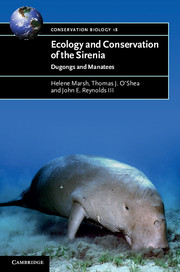Book contents
- Frontmatter
- Contents
- Foreword
- Preface
- Acknowledgements
- 1 Introduction
- 2 Steller’s sea cow
- 3 Affinities, origins and diversity of the Sirenia through time
- 4 Feeding biology
- 5 Behaviour and habitat use
- 6 Life history, reproductive biology and population dynamics
- 7 Threats
- 8 Conservation status
- 9 Conservation opportunities
- References
- List of online supplementary material
- Index
- Plate section
1 - Introduction
Published online by Cambridge University Press: 05 January 2012
- Frontmatter
- Contents
- Foreword
- Preface
- Acknowledgements
- 1 Introduction
- 2 Steller’s sea cow
- 3 Affinities, origins and diversity of the Sirenia through time
- 4 Feeding biology
- 5 Behaviour and habitat use
- 6 Life history, reproductive biology and population dynamics
- 7 Threats
- 8 Conservation status
- 9 Conservation opportunities
- References
- List of online supplementary material
- Index
- Plate section
Summary
In 2008 a US federal court judge ruled that the Defense Department’s plans to construct an offshore marine airbase on the island of Okinawa, Japan contravened the US National Historic Preservation Act of 1966 (Tanji 2008). The rationale for the court’s decision, known as Dugong v. Gates, was that construction plans for the base failed to protect the dugong, one of the animals that are the subjects of this book. The dugong is listed as critically endangered by the Japanese Ministry of the Environment and as a National Monument on the Japanese Register of Cultural Properties because of its high cultural value to the people of Okinawa. In 2005 a companion court case (Dugong v. Rumsfeld) had established the legitimacy of declaring an animal to be a historically significant ‘property’ under US legislation, ensuring that the US National Historic Preservation Act of 1966 applied.
The outcome of these court cases does not guarantee the future of the dugong in Japan, where it is subject to multiple threats in addition to the airbase (Marsh et al. 2002; Ikeda and Mukai 2012; Chapter 8). Indeed, the court decision seems unlikely to prevent the construction of the airbase.
- Type
- Chapter
- Information
- Ecology and Conservation of the SireniaDugongs and Manatees, pp. 1 - 12Publisher: Cambridge University PressPrint publication year: 2011
- 1
- Cited by

